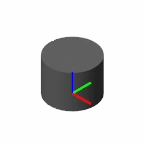Variable Cylindrical Solid
Solid cylinder with variable mass and size
Libraries:
Simscape /
Multibody /
Body Elements /
Variable Mass
Description
The Variable Cylindrical Solid block adds to the attached frame a solid cylinder with variable mass and side. The mass, radius, and length of the cylinder can each be constant or vary with time. A variable quantity can be specified directly as a physical signal or it can be calculated as a function of the remaining quantities. Either the mass or the cylinder dimensions can be calculated during simulation, but not both simultaneously.
A reference frame encodes the position and orientation of the solid in a model. The
frame is fixed to the solid with the frame origin at the center of the lower surface (as
observed with a Z up view convention). This placement is
preserved throughout simulation. Length increases asymmetrically relative to the lower
surface, along the positive direction of the z-axis.
Variable Cylinder with Length Calculated from Mass

Visualization is dynamic. Solid dimensions update continuously as they occur, in the visualization pane of Multibody Explorer. The initial dimensions of the solid depend on the parameters and physical signals that you specify. It is possible for a variable dimension to begin with a zero value—for example, if it derives from a physical signal whose initial value is zero also.
Density can itself be constant or variable. This quantity is specified as a constant if at least one solid parameter is calculated during simulation. It is calculated as a variable if all solid parameters are explicitly specified, either as (constant) block parameters or as physical signals. As in the case of the solid blocks, you can specify a negative density, for example, to model voids in compound bodies.
Examples
Ports
Frame
Physical Signal Input
Physical Signal Output
Parameters
Extended Capabilities
Version History
Introduced in R2017b

